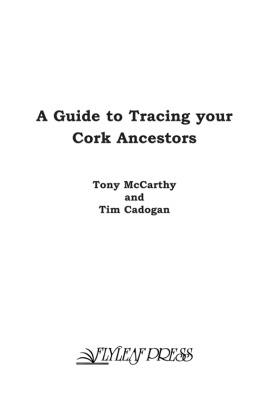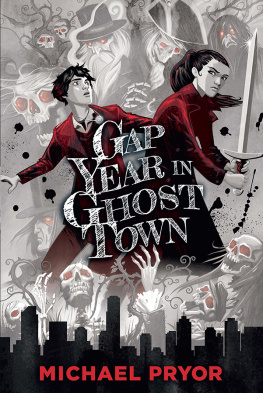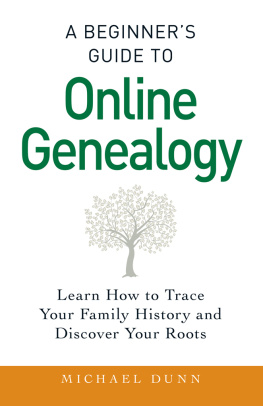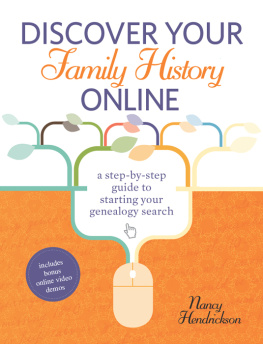All rights reserved. No part of this publication may be reproduced, stored in a retrieval system, or transmitted, in any form or by any means, electronic, mechanical photocopying, recording or otherwise without the prior permission of the copyright owner. The information in this book is subject to change without notice.
Cover Design by Cathy Henderson showing a scene from the Coal Quay market in Cork City.
Tables and Illustrations
Computer-generated pedigree chart
1911 Census Return Form
Table 2: Catholic Parishes
The Parliamentary Gazeteer of Ireland, Extract
from: Whos Who in The Irish Civil War & War of Indepencence
Preface to Second Edition
W hen the first edition of this book was published in 1998, genealogy was still an old fashioned pursuit. For many it brought to mind images of middle aged people, mooching around in graveyards. The popular TV series Who Do You Think You Are? has done wonders to change the public perception of genealogy and its enthusiasts. Any week, repeats of episodes in this series can be seen on TV. Each show fast-tracks a celebrity through the highs and lows of genealogical research. The vast resources available to a TV company ensures that interesting discoveries are always made. This association with celebrity has made genealogy cool.
However, a far more important change over the last decade or so, was the quantum leap in information and communication technology. The advent and development of the internet has revolutionised family history. It is now possible to research many of the most important Irish genealogical records, without leaving your home or spending a cent! For a small outlay on CDs and DVDs, you can possess facsimiles of vast quantities of archives that can be searched in seconds for the names of your ancestors. You can compile a reference library of some of the most important works of Irish genealogy by downloading books from the internet, legally and for free. These books include such useful family history classics as Mathesons Special Report on Surnames in Ireland (1894), Sir Bernard Burkes Landed Gentry of Ireland (1912), and A Topographical Dictionary of Ireland (1837) by Samuel Lewis.
Storing and retrieving information about ancestors used to be a major problem. Now, inexpensive and user-friendly computer programmes do this work for you. Drawing up family tree charts was the bane of the genealogists life. Having, with ruler and pencil, produced a chart of six or seven generations, family historians often had the dubious pleasure of discovering a previously unknown ancestor, and had no option but to reach for the eraser or, more often than not, to start again.
Almost all of the changes made in this, the second edition of Tracing your Cork Ancestors, have been necessitated by the technological advances mentioned above. The sources of ancestral information are the same as they were thirteen years ago when the book was first published. Census returns, civil records of births, deaths and marriages; Church Registers, Griffiths Valuation, tithe applotment books, wills, gravestone inscriptions and so on, still constitute the genealogists source material. However, accessing and researching these sources have been revolutionised. What would have been impossible in 1998 without an army of competent researchers can now be achieved by the push of a button.
Information on other relevant changes, in particular, publications over the last thirteen years, have also been included. A number of suggestions were made by readers of the first edition and some of these have found their way into the second edition.

Computers make easy work of ancestry charts
Chapter 1 Introduction
T racing your Cork ancestors: within the confines of this small book, it is not possible to deal comprehensively with this theme. Some explanation, therefore, is required with regard to what we have left out and what we have focused on.
Cork is the biggest of Irelands 32 counties. With an area of almost 3,000 square miles it constitutes roughly nine per cent of the island, and it has a population to match. The 1841 census indicated that 850,000 people, that is ten per cent of the entire population, lived in Cork. The most recent population statistics indicate that Ireland now has a population of a little over 6 million, with Cork being home to over 480,000 of them. While not quite retaining its mid-nineteenth century share of the population, it still accounts for eight percent of Irelands people.
The second city of the Republic, also called Cork, lies within the confines of the county, as do about twenty sizeable by Irish standards at least towns. Down-river from Cork is the harbour town of Cobh, formerly Queenstown and earlier called Cove or the Cove of Cork. This was the principal port of emigration from Ireland to North America from the late 1850s for almost a century.
In size and population, Cork is three times as large as the average Irish county. The book makes an effort to range over the whole county.
As in the rest of Ireland, Cork people belonged to different social classes, different religious denominations, and worked at a variety of jobs. These factors are important as far as genealogical research is concerned, and none of the major groupings is ignored.
A very old tradition, recorded in the Annals of the Four Masters, states that the first people who came to Ireland, landed in Cork, and archaeologists have confirmed that the county has been inhabited for thousands of years. But even the most optimistic of genealogists does not expect his research to carry him back to remote times. For the majority of Irish people, genealogically relevant documentation runs out around the beginning of the nineteenth century. The book, therefore, concentrates on records generated over the last two centuries.
People researching Cork-based family trees can have quite different needs as far as advice is concerned. Some may be just getting used to the basics, while others may be deeply involved in arcane sources. It was thought best to presuppose very little knowledge on the part of the reader, so bear with us when we explain the obvious. The more advanced researcher should find the tables of information on parish records useful, and may come across occasional references to some local sources which may not have come up for attention previously.












